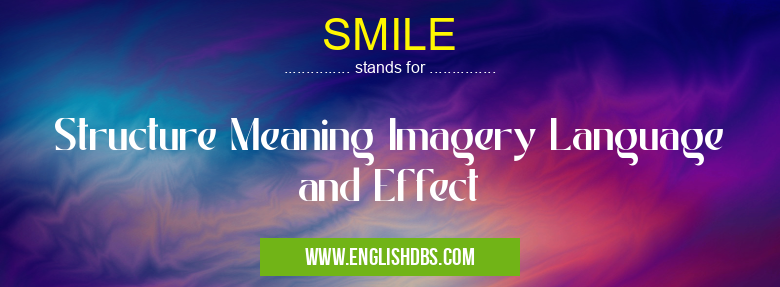What does SMILE mean in LANGUAGE & LITERATURE
SMILE is an acronym that stands for Structure Meaning Imagery Language and Effect. It provides a comprehensive framework for understanding how meaning is communicated through different types of written, verbal and visual forms. SMILE helps us to understand the various ways we convey ideas, feelings and information and to practice using these skills in both our personal and professional lives. SMILE takes into account the power of language, imagery, structure, tone and emotion to create powerful messages that can both inform and move people. By having an in-depth understanding of SMILE, one can use it as a tool to create or interpret communication that is both effective and meaningful.

SMILE meaning in Language & Literature in Academic & Science
SMILE mostly used in an acronym Language & Literature in Category Academic & Science that means Structure Meaning Imagery Language and Effect
Shorthand: SMILE,
Full Form: Structure Meaning Imagery Language and Effect
For more information of "Structure Meaning Imagery Language and Effect", see the section below.
Structure
At the foundation of all effective communication lies structure; this includes syntax, grammar, rhetoric choices etc. In order to be able to truly convey an idea or feeling one needs to consider the overall composition of their message. This includes breaking down what kind of words will best relay their message as well as considering any non-verbal factors such as body language or facial expressions which could affect how the message is interpreted by the receiver. Having a strong sense of structure allows one to create a cohesive narrative that can be understood by listeners properly.
Meaning
The importance of meaning in communication cannot be overstated; when trying to express an idea effectively choosing the right words are essential for conveying what you need to say correctly. This means we must not only consider what words we will use but take into account any connotations or implications associated with them depending on context or background knowledge of those listening/reading your content.Taking care in crafting your message carefully ensures it is received in the way you intended.
Imagery
Imagery plays a vital role when it comes to effective communication; using metaphors or similes allows us to paint beautiful pictures with words that help bring ideas alive for those receiving them. Imagery gives our messages more depth allowing us tap into emotions within its audience whilst being more concrete than abstract concepts alone allowing us more effectively communicate our thoughts.
Language
Language also plays an important role as even if one understands what they wish they say they still need be able crafting that into meaningful sentences which make sense upon delivery. Taking time assess each word when constructing your sentences helps ensure accuracy no matter who your intended target audience may be while ensuring a fluidity throughout.
Effect
Finally having considered all other aspects it's important look at what affect (if any)the message has had after delivery; this means assessing whether was understood correctly looked at any emotional response caused as well mode audience interaction if necessary.. Having seen effect your messaging had can then used adjust future communications ensure similar results received again.
Essential Questions and Answers on Structure Meaning Imagery Language and Effect in "SCIENCE»LITERATURE"
What is SMILE?
SMILE stands for Structure Meaning Imagery Language and Effect. It is a framework designed to help analyze spoken, written or visual communications in order to evaluate the effectiveness of the message.
What are some benefits of using the SMILE framework?
The SMILE framework can provide insight into how an audience may view a message and impact their perception of it. This allows professionals to create more targeted and effective communications by understanding their audience's point of view. Additionally, the framework enables practitioners to assess how different media platforms may influence their message's impact.
How do I use SMILE when creating communications?
When utilizing the SMILE model, it's important to consider each element independantly and in relation to each other. Structure should be used to identify how your communication is organized, providing clarity and better engagement with your audience. Meaning can help solidify your ideas by connecting them interally, while imagery will make it easier for audiences to comprehend complex concepts quickly. Language should be as concise as possible while still conveying your intended message, while effect allows you to evaluate whether or not your communication had its desired outcome.
How can I ensure that my written communication has maximum impact?
Utilizing the SMILE model can ensure that your written communication has maximum impact. Taking time at each stage to analyze structure, meaning, imagery language and effect will help you craft more effective messages that fulfill all stages of receiving any sort of communication. Additionally, remember that there is no one size fits all approach when creating effective communications - different methods work for different audiences! Consider who you are trying to reach and tailor your messages accordingly.
Is there a specific language I should use when crafting an effective message?
It depends on who you're targeting with your message! Crafting a clear message is essential but make sure that you consider who you're writing for; their level of knowledge on the subject matter should influence what type of language you're using — avoid industry jargon if most people won't understand it! Keep sentences concise yet informative; make sure they contain useful information but don't ramble on too much (
Final Words:
In conclusion SMILE encompasses all aspects needed successful communication from structure language imagery bearing mind how each piece affects other form whole picture. By taking time understand its principles practitioners should better prepared comprehending interpreting messages helpfully creating their own communicating effectively those around them taking productivity relationships next level.
SMILE also stands for: |
|
| All stands for SMILE |
